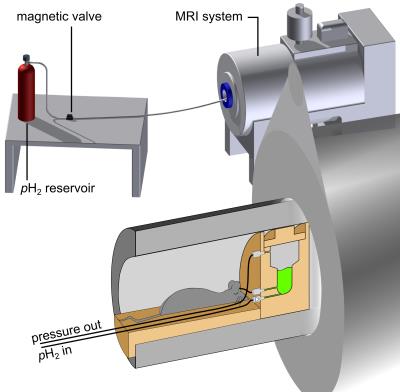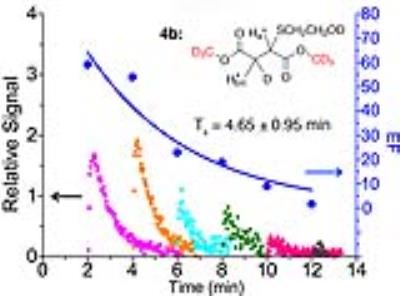Monday, 24 April 2017
| Room 312 |
13:45 - 15:45 |
Moderators: Angus Lau, Rolf Schulte |
Slack Channel: #s_mrs_molecular
Session Number: O49
13:45
 |
0162.
 |
Chemical Shift Imaging of pH with Hyperpolarized [2-13C,D10] Diethylmalonic Acid 
David Korenchan, Celine Taglang, Cornelius von Morze, Joseph Blecha, Jeremy Gordon, Peder Larson, Henry VanBrocklin, John Kurhanewicz, David Wilson, Robert Flavell
Imaging tumoral pH may aid in characterizing aggressiveness, metastasis, and therapeutic response. The study of hyperpolarized (HP) 13C chemical shift-based probes addresses some of the limitations of previously reported ratiometric methods, including HP 13C bicarbonate. We report the development of HP [2-13C,D10] diethylmalonic acid as a pH imaging agent, which exhibits a significant 13C chemical shift difference over the physiologic pH range. We demonstrate that this compound can be copolarized with tert-butanol to accurately measure pH in phantom studies. Furthermore, this HP compound showed high in vivo SNR in a murine model of prostate cancer.
|
13:57
 |
0163.
 |
Long-lasting, liquid-state 13C hyperpolarization > 20 % generated in an MRI system within seconds enables fast 13C imaging - permission withheld
Andreas Schmidt, Stephan Berner, Waldemar Schimpf, Christoph Müller, Thomas Lickert, Niels Schwaderlapp, Stephan Knecht, Jason Skinner, Anna Dost, Philipp Rovedo, Jürgen Hennig, Dominik von Elverfeldt, Jan-Bernd Hövener
Current methods for the production of hyperpolarized 13C-tracers require a dedicated, complex and costly polarizer device. Here we present, for the first time, 13C-hyperpolarization >20% and ex-vivo 13C-MRI without an external polarizer, but by using the hardware of an MRI system instead: a simple, low-cost (≈1000€) setup was built and high-field spin-order-transfer sequences were exploited to transfer the spin-order of parahydrogen to 13C;the implementation on any multinuclear MRI system appears feasible. The tracer is produced near the application site and subsequent 13C-MRI is possible without transfer of the sample, at a fraction of the cost and complexity of external polarizers.
|
14:09
|
0164.
 |
Hyperpolarized Nuclear Spin Singlets. Opportunities for Polarization Storage. What Limits Their Lifetimes? - permission withheld
Alexej Jerschow, Yuning Zhang, Xueyou Duan, Vladimir Sychrovsky, James Canary
Hyperpolarization techniques have offered the prospect of higher sensitivity and fast imaging, as well as tracking of metabolism in real-time. Nuclear spin singlet states allow the storage of polarization for an extended period of time. Here we present results on the limiting factors for nuclear singlet state lifetimes, and methods by which they can be determined in organic molecules, which is important for designing appropriate contrast agents, or hyperpolarization techniques that track metabolites.
|
14:21
|
0165.
 |
Metabolic imaging of neuroinflammation in the cuprizone mouse model for Multiple Sclerosis using hyperpolarized [1-13C] pyruvate 
Caroline Guglielmetti, Chloe Najac, Annemie Van der Linden, Sabrina Ronen, Myriam Chaumeil
Our study demonstrates that metabolic imaging of hyperpolarized [1-13C] pyruvate can detect increased hyperpolarized lactate production in vivo in highly inflammatory white matter lesions in a preclinical model of Multiple Sclerosis. Increased lactate production was associated with the presence of pro-inflammatory macrophages upregulating pyruvate dehydrogenase kinase 1, as well as regional inhibition of pyruvate dehydrogenase, providing a likely mechanism for a decrease subsequent flux of pyruvate towards the Krebs cycle. Our study demonstrates that metabolic imaging of hyperpolarized [1-13C] pyruvate has high potential for in-vivo detection and monitoring of neuroinflammation levels during demyelination and remyelination.
|
14:33
 |
0166.
 |
Effects of 3-MPA on in vivo hepatic metabolism of hyperpolarized [1-13C] pyruvate 
Emine Can, Hikari A.I. Yoshihara, Jessica A.M. Bastiaansen, Rolf Gruetter, Arnaud Comment
Ex vivo and in vivo studies on liver metabolism using hyperpolarized [1-13C]pyruvate report do not agree on whether hyperpolarized bicarbonate metabolite production results from pyruvate oxidation or gluconeogenesis. This study tested the ability of hyperpolarized [1-13C]pyruvate to probe gluconeogenesis in the liver of intact rats. While conversion to hyperpolarized bicarbonate was detected in the liver of fasted rats, treatment with the phosphoenolpyruvate carboxykinase inhibitor 3-mercaptopicolinc acid resulted in 7-fold lower levels. This result supports the notion that hepatic gluconeogenic metabolism can indeed be directly probed in vivo with hyperpolarized pyruvate.
|
14:45
|
0167.
 |
[2-13C]dihydroxyacetone as a real-time, in vivo sensor of acute hepatic and renal metabolic response after a fructose and glucose challenge 
Irene Marco-Rius, Cornelius Von Morze, Renuka Sriram, Peng Cao, Gene-Yuan Chang, Eugene Milshteyn, Robert Bok, Michael Ohliger, David Pearce, John Kurhanewicz, Peder Larson, Dan Vigneron, Matthew Merritt
Hyperpolarized [2-13C]dihydroxyacetone was used to investigate the hepatic and renal metabolic response to acute intravenous administration of glucose or fructose in rats in vivo. 13C-MR spectra were acquired before, 10 minutes and 80 minutes after the carbohydrate solution delivery. Changes in the metabolic products phosphoenolpyruvate (PEP) and glycerol 3-phosphate (G3P) were detected after fructose injection, while no metabolic perturbation was detected after the glucose injection. The observed effects possibly include ATP depletion and changes in the unlabelled pool sizes of glycolytic intermediates.
|
14:57
|
0168.
 |
Hyperpolarized 13C Magnetic Resonance Evaluation of Renal Ischemia Reperfusion Injury in a Murine Model 
Celine Baligand, Hecong Qin, Aisha True-Yasaki, Jeremy Gordon, Cornelius VonMorze, Justin DeLos Santos, Joy Walker, David Wilson, Robert Raffai, John Kurhanewicz, David Lovett, Zhen Wang
Persistent oxidative stress and mitochondrial dysfunction have been implicated across diverse forms of acute kidney injury and in the transition to chronic kidney disease. We show that HP 13C metabolic MR can be used to noninvasively assess the altered renal redox capacity and mitochondrial PDH activity following ischemic reperfusion injury. Such an imaging approach can potentially enhance the prediction and monitoring of progressive kidney injury.
|
15:09
|
0169.
 |
Towards Quantitative Cardiac First-Pass Perfusion Imaging using Hyperpolarized [13]-Urea 
Maximilian Fuetterer, Julia Busch, Sophie Peereboom, Lukas Wissmann, Constantin von Deuster, Nikola Cesarovic, Miriam Lipiski, Christian Stoeck, Sebastian Kozerke
Hyperpolarized [13C] urea perfusion imaging using velocity-selective excitation is qualitatively and semi-quantitatively compared with clinically used [1H] Gadolinium first-pass perfusion imaging in healthy pigs. Higher contrast-to-noise ratios and comparable sensitivity for semi-quantitative perfusion measures over myocardial sectors can be achieved with [13C] urea. Arterial input sampling in the ascending aorta using a second imaging slice with conventional excitation is proposed. Feasibility of accurate absolute myocardial blood flow quantification using [13C] urea is demonstrated.
|
15:21
|
0170.
 |
Measurement of metabolic changes in acute doxorubicin-induced cardiotoxicity in mice using hyperpolarized [1-13C]pyruvate 
David Martin, Hikari Yoshihara, Emine Can, Roger Hullin, Jessica Bastiaansen
Chemotherapy cocktails containing doxorubicin produce irreversible cardiotoxic side effects that may progress to heart failure, which can only be avoided through dose limitation of the chemotherapeutic agents. Increasing evidence suggest that cardiac dysfunction caused by doxorubicin is triggered by an energetic deficit and alterations in mitochondrial metabolism. We quantified metabolic changes in vivo in a mouse model of acute doxorubicin-induced cardiotoxicity using hyperpolarized 13C MRS.
|
15:33
|
0171.
 |
Imaging c-Myc: Identification of metabolic phenotypes using MRSI of hyperpolarised [1-13C]pyruvate to [1-13C]lactate flux in glioblastoma patient-derived orthotopic xenografts. 
Richard Mair, Alan Wright, Colin Watts, Kevin Brindle
Heterogeneity at both a genomic and phenotypic level is extant within glioblastoma. We hypothesised that imaging of the flux from hyperpolarised [1-13C]pyruvate to [1-13C]lactate may inform upon this heterogeneity. We used patient derived orthotopic xenograft cohorts to identify differential lactate labelling and have related this to both glycolytic enzyme and c-Myc expression.
|
|











